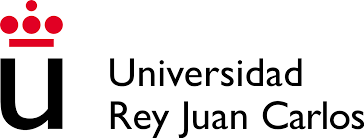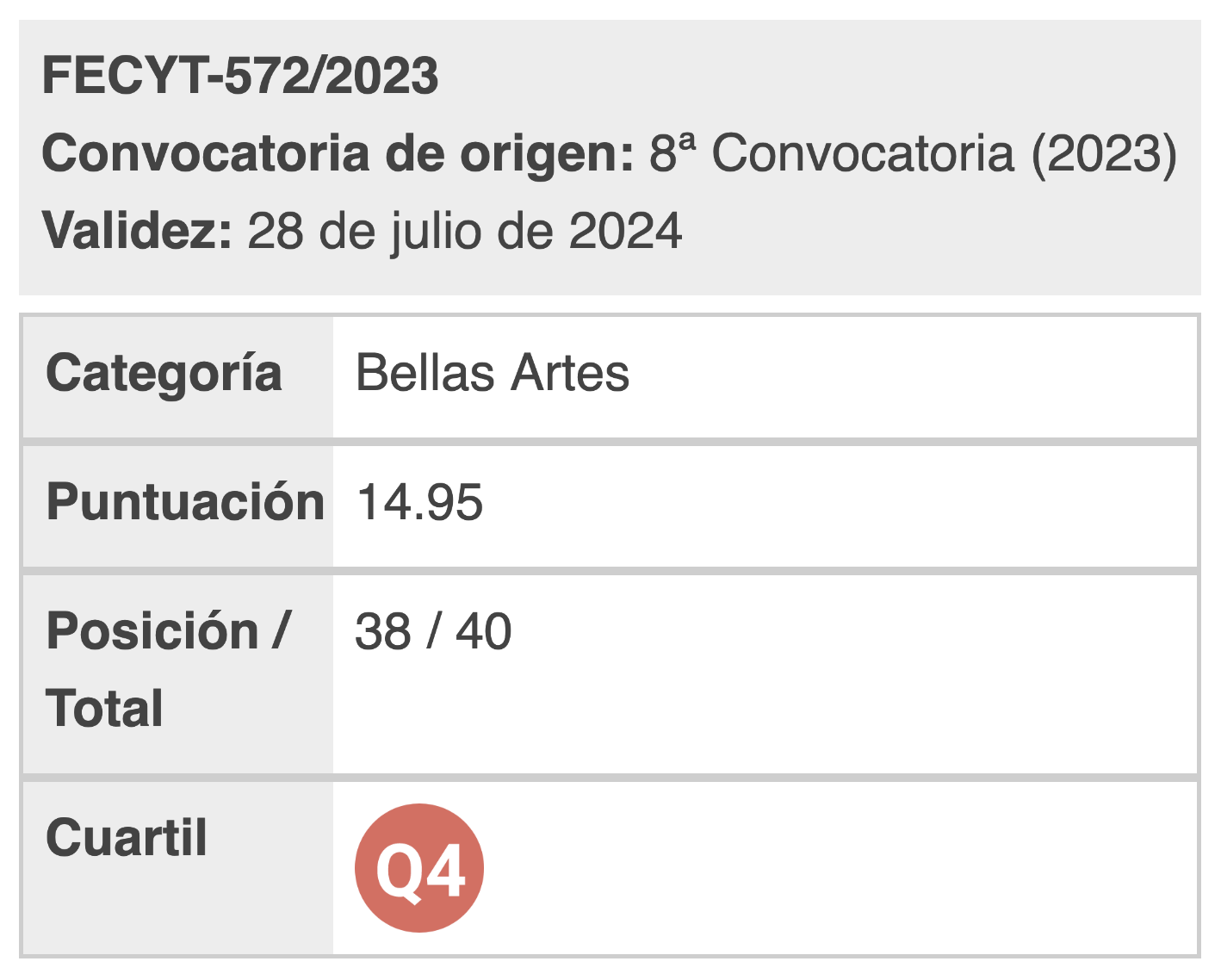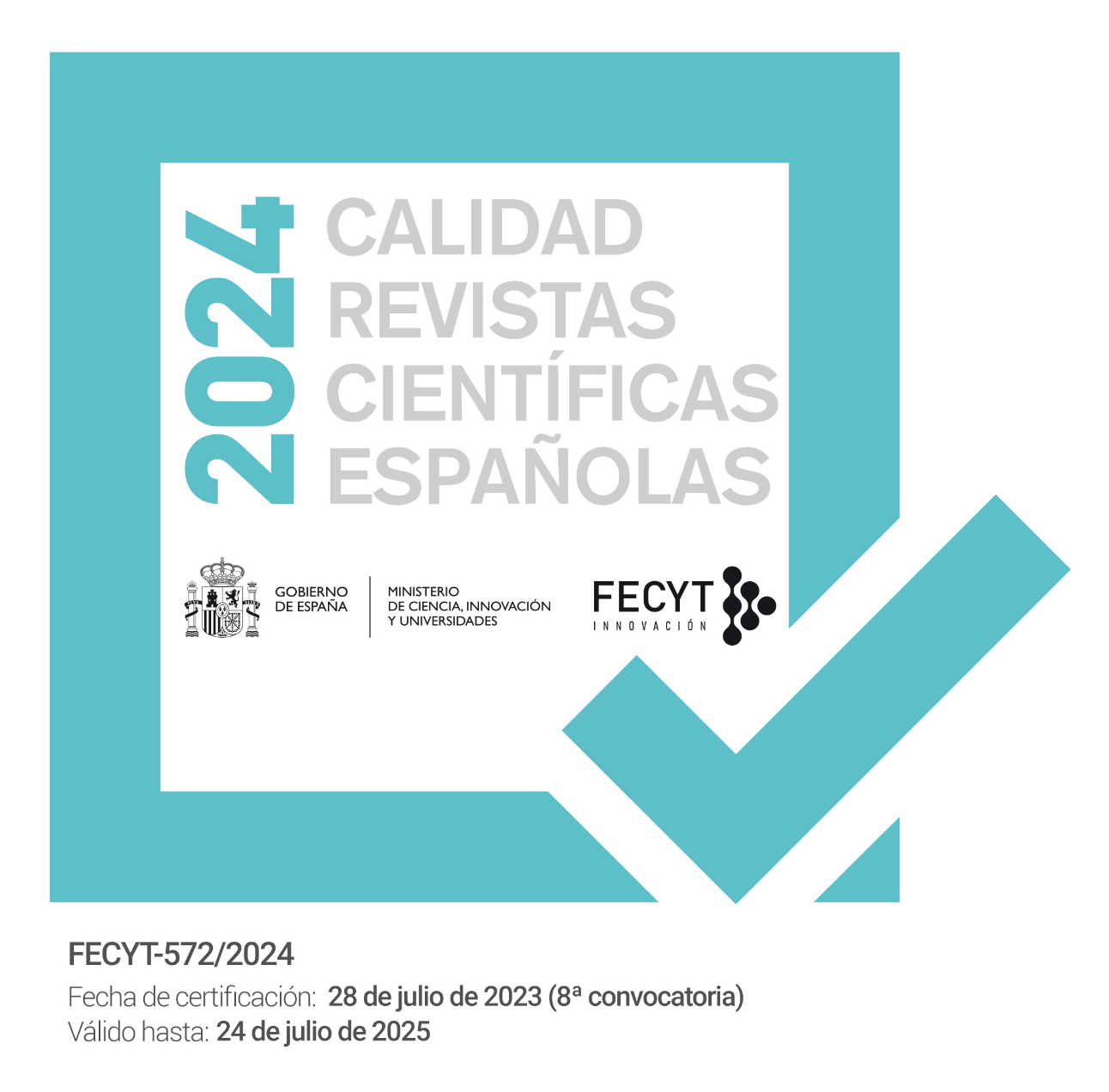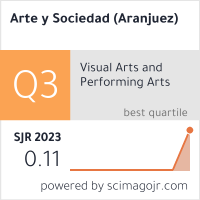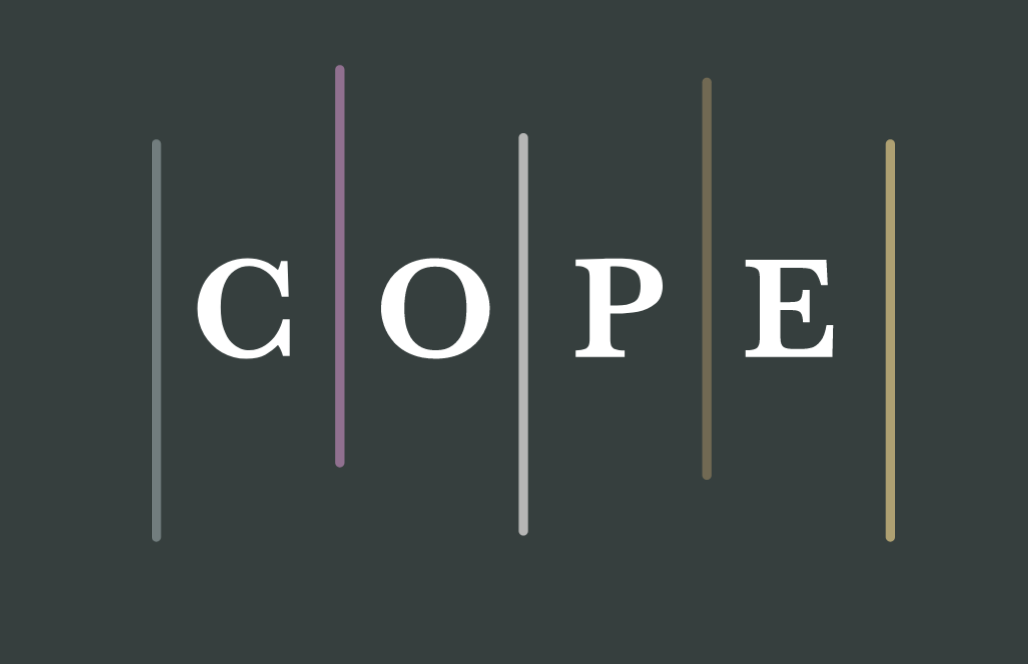Pedagogical sense of artistic disciplines from the vision of the artists
DOI:
https://doi.org/10.33732/ASRI.6154Keywords:
Pedagogical significance, Artistic disciplines, ontological significance, Life PhilosophyAbstract
Abstract
The objective of this research was to identify the pedagogical significance perceived by professionals in different artistic disciplines such as visual and stage arts, as well as how the learnings from these disciplines have linked or transferred into their daily life. For the purposes of this work, the pedagogical significance was constructed from four substantial elements: epistemological, heuristic, hermeneutic and ontological.
The findings indicate that in addition to the knowledge attained through the study of a discipline it acts as a valuable tool for facing life as it captivates, build passion, and unleash body awareness and feeling of freedom. Through art, the interviewed create their philosophy of life, strengthen their axiological system and reach life balance.
References
Aguilar, L. A. (2004). La hermenéutica filosófica de Gadamer. Sinéctica. Revista Electrónica de Educación, (24), 61-64. https://www.redalyc.org/pdf/998/99815918009.pdf
Bajardi, A. (2016). Aportaciones de las Disciplinas Artísticas al desarrollo de Competencias Socioemocionales y a la Configuración de la Identidad. Opción: Revista de Ciencias Humanas y Sociales, (13), 53-72. https://www.redalyc.org/pdf/310/31048483004.pdf
Barboza, P. (2017). Las mujeres y el arte como forma propia de deconstrucción: Un debate implícito. Revista Rupturas, 7(1),51-74). https://doi.org/10.22458/rr.v7i1.1611
Barriga, M. L. (2011). Estado del arte y definición de términos sobre el tema "La investigación en educación artística". El Artista, (8), 224-241. https://www.redalyc.org/pdf/874/87420931015.pdf
Belén, P. S. (2019). Arte y conocimiento. La dimensión epistémica del proceso artístico en la contemporaneidad. Revista Humanidades, 9(2), 1-16. https://doi.org/10.15517/h.v9i2.37126
Berruezo, C. y Morón, M. (2021) La construcción de la identidad a través del arte en personas en riesgo de exclusión social. Arteterapia. Papeles de Arteterapia y Educación para Inclusión Social, 16, 11-21. https://doi.org/10.5209/arte.71152
Bolívar, A. (2013). La lógica del compromiso del profesorado y la responsabilidad de la escuela. Una nueva mirada. REICE. Revista Iberoamericana sobre Calidad, Eficacia y Cambio en Educación, 11(2), 60-86. https://www.redalyc.org/pdf/551/55127024003.pdf
Borgdorff, H. (2010). El debate sobre la investigación en las artes. Cairon: Revista de ciencias de la danza, (13), 25-46. https://shre.ink/Borgdorff
Calvo, R. M. (2022). Uso de la Mnemotecnia como herramienta educativa de la Sociedad del Conocimiento en la Era Digital. [Tesis doctoral no publicada]. Universidad del País Vasco- Euskal Herriko Unibertsitatea
Castells, M. (2002). El poder de la identidad. Alianza Editorial
Csikszentmihalyi, M. (2011). Fluir, una psicología de la felicidad. Kairós Editorial
Duckworth, A. L. y Eskreis-Winkler, L. (2015). Grit. En J. D. Wright (Ed.), International Encyclopedia of the Social and Behavioral Sciences (pp.397-401). Elsevier.
Fernández, G. P. (2018). Investigación teórico-plástica a través de diferentes disciplinas artísticas, de la evolución dirigida al desarrollo de la conciencia, según la física cuántica, la filosofía, la psicología y el yoga. [Tesis doctoral no publicada]. Universidad Complutense de Madrid.
Ferreira, M. A. (2009). Un enfoque pedagógico de la danza. Revista Educación Física Chile, 80(268), 9-21. http://revistas.umce.cl/index.php/refc/article/view/2122
Fragoso, S. C. (2019). Las disciplinas artísticas en la educación básica como factor de desarrollo cognitivo. Trayectoria. Práctica Docente en Educación Artística, 6, 78-88. https://shre.ink/Fragoso
Fructuoso, C. y Gómez, C. (2001). La danza como elemento educativo en el adolescente. Educación Física y Deportes, 66, 31-37. https://raco.cat/index.php/ApuntsEFD/article/view/301902
García, S. y Belén, P. S., (2011). Perspectivas ontológicas, epistemológicas y metodológicas de la investigación artística. Paradigmas, 3, 89-107. https://shre.ink/PerpectivasOntologicas
García, V. A. (2010). Las 9 musas, la inspiración. Activarte. Revista independiente de Arte, teoría de las artes, pedagogía, nuevas tecnologías, 3, 12-17. https://shre.ink/GarciaLas9musas
González, B. y León, A. (2013). Procesos cognitivos de la prescripción curricular a la praxis educativa. Revista de Teoría y Didáctica de las Ciencias Sociales, 19, 49-67.
https://www.redalyc.org/articulo.oa?id=65232225004
Guzmán, L., J. A., López, B., M. y Torres, I. D., (2012). Metodologías y métodos para la construcción de ontologías. Scientia Et Technica, 2(50), 133–140. http://www.redalyc.org/articulo.oa?id=84923878033
Hadot, P. (2009). Filosofía como forma de vida Edit. Alpha Decay.
Hernández, M., Tolino, A., Pérez, R., Pitera, I. (2018, marzo 15-29). La educación en valores a través del teatro. [Conferencia]. III Congreso Internacional Virtual sobre La Educación en el Siglo XXI, Málaga, España. https://www.eumed.net/actas/18/educacion/index.html
Huertas, D. P. y Morales, P. (2012). Estado de gestión de la enseñanza de las artes escénicas en localidades de Bogotá. (pensamiento), (palabra) y obra, (8), 24-35. https://doi.org/10.17227/ppo.num8-1741
Ivcevic, Z., Hoffmann, J. y Brackett, M. (2014). Artes y emociones que potencian la creatividad. Fundación Botín. https://shre.ink/IvcevicArteyEmociones
Jiménez, R., C. Pesci G.E. (2020). Estética heurística y diseño (picto)gráfico. Revista Digital FILHA, 15(23), 1-32. http://ricaxcan.uaz.edu.mx/jspui/handle/20.500.11845/2065
Kalliath, T. y Brough, P. (2008) Work-life balance: A review of the meaning of the balance construct [Balance trabajo-vida: una revisión del significado del constructo balance]. Journal of Management & Organization, 14(03), 323-327. https://doi.org/10.5172/jmo.837.14.3.323
Llinás, R. (2009). “El arte es una expresión del cerebro que se utiliza para comunicar”. En: Entrevista a Dr. Rodolfo Llinás por Ayala, R. Polemíkós. Ciencias de la comunicación, Los Libertadores. Bogotá, D.C. (pp. 109-117). https://shre.ink/LlinasArtecomoexpresiondelcerebro
López, V. D. (2022). De la apropiación a la desapropiación del cuerpo [Tesis de maestría no publicada]. Universidad Autónoma del Estado de México. https://riaa.uaem.mx/handle/20.500.12055/2585
Mandolini, R. (2013). Heurística y Arte: una contribución para la comprensión de los procesos artísticos creativos. Revista del Instituto de Filosofía, 1(1), 63 – 92. https://doi.org/10.22370/rhv2013iss1pp63-92
Merchan, C. (2010). Implicaciones del carácter cognitivo del arte en la educación artística escénica. Algunos aportes para el docente en artes escénicas a nivel escolar. (pensamiento), (palabra). Y obra, 3, 138-141. https://doi.org/10.17227/ppo.num3-435
Monasterio, A. (2016). Filosofía de la danza: Cuerpo y expresión simbólica. Daimon. Revista Internacional de Filosofía, 5, 295–305.
Montero, P. (2005). Cassirer y Gadamer: El arte como símbolo. Revista de Filosofía, 23(51), 58-69. https://ve.scielo.org/scielo.php?script=sci_arttext&pid=S0798-11712005000300004
Niemiec, R. (2019). Six Functions of Character Strengths for Thriving at Times of Adversity and Opportunity: a Theoretical Perspective [Seis funciones de las fortalezas del carácter para prosperar en tiempos de adversidad y oportunidad: una perspectiva teórica]. Springer.
Pérez, A.C. (2022). Reflexiones sobre la epistemología dancística desde el baile flamenco, Revista de Artes Escénicas y Performatividad, 13(21), 158-168. https://doi.org/10.25009/it.v13i21.2705
Pérez-Cuevas, C.A. (2020, enero 11). Sabia virtud. Revista Siempre. http://www.siempre.mx/2020/01/sabia-virtud/
Prioló, D. E. (2019). Fortalecimiento de la identidad personal por medio de las artes plásticas [Tesis de licenciatura no publicada]. Universidad Santo Tomás Bogotá.
Rincón, V. J. C. (2007) Filosofía de la Educación y Teoría de los Valores: el subjetivismo y el objetivismo en la axiología. Educació i Cultura, 19, 19-35. http://hdl.handle.net/11162/5646
Ríos-Flórez, J. A. (2016). Activación de las redes neuronales del arte y la creatividad en la rehabilitación neuropsicológica. Cuadernos Hispanoamericanos De Psicología, 15(2), 47–60.
https://doi.org/10.18270/chps..v15i2.1913
Rogers, C. (1989). On Becoming a Person. Houghton Mifflin Company
Ruiz, D. (2018). El arte definido como arte comunicativo. Revista AV Notas, 6, 111-123. https://core.ac.uk/download/pdf/230282539.pdf
Sabeckis, C. (2013). El séptimo arte en la era de la revolución tecnológica. Cuadernos del Centro de Estudios en Diseño y Comunicación. Ensayos, 45, 53-64. https://shre.ink/SabeckisElSeptimoArte
Sastre, A. C. (2007) Construcción del sujeto en la danza. Revista Hallazgos, 7, 195-209.
http://www.redalyc.org/articulo.oa?id=413835168012
Seligman, M. E. P. (2011). Flourish. Free Press.
Strauss, A. y Corbin, J. (2002). Bases de la investigación cualitativa. Universidad de Antioquía.
Taylor, S. J. & Bogdan; R. (1994). Introducción a los métodos cualitativos. Ed. Paidós.
Touriñán, L. J. M. (2011). Claves para aproximarse a la educación artística en el sistema educativo: educación “por” las artes y educación “para” un arte. ESE. Estudios sobre educación, 21, 61-81.
https://hdl.handle.net/10171/22549
Vargas, A. J. (2015). Sentido y significado pedagógico- cultural de las experiencias trabajadas por maestros investigadores desde la escuela. Educación y Ciudad, 12, 115–138.
https://doi.org/10.36737/01230425.n12.181
Verdera, J. C. R. (2006). Filosofía de la educación y teoría de los valores: El subjetivismo y el objetivismo en la axiología. Educació i Cultura: Revista Mallorquina de Pedagogía, 19, 19-36.
https://shre.ink/VerderaFilosofiadelaEducacion
Vicente, S. (2006). Arte y parte: la controvertida cuestión de la investigación artística. En R. Gotthelf (Ed.), La investigación desde sus protagonistas; Senderos y estrategias. Ediunc.
https://shre.ink/VicenteArteyParte
Vilar, G. (2018). Las razones del arte. Antonio Machado Libros.

Downloads
Published
How to Cite
Issue
Section
License

This work is licensed under a Creative Commons Attribution 4.0 International License.
You are free to:
Share — copy and redistribute the material in any medium or format.
Adapt — remix, transform, and build on the material for any purpose, including commercial.
Attribution — You must properly acknowledge the authorship, provide a link to the license, and indicate if any changes have been made.
You may do so in any reasonable manner, but not in any way that suggests that you endorse or receive any endorsement by the licensor for your use.
No additional restrictions — You may not apply legal terms or technological measures that legally restrict you from doing what the license allows.

